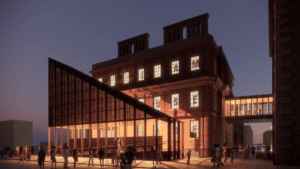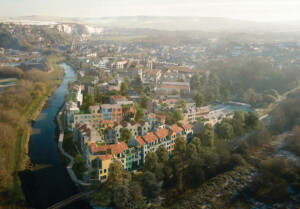A planned seated zip line attraction that would have seen thrill-seekers sail high above Liverpool, England’s historic city center has been shelved after Mayor Joe Anderson stepped in to put an end to the controversial project.
This isn’t to say that a future zip line located somewhere in Liverpool has been completely scrapped; it would seem that the proverbial door has been left open to Welsh aerial adventure company Zip World to discuss other potential sites in and around England’s tenth largest municipality. However, the proposed site in central Liverpool that had previously received planning permission from the city council, a move that sparked a legal challenge from heritage organization the Victorian Society seeking a judicial review into the process, is dead.
While local business owners had expressed enthusiastic support for the over 1,300-foot-long vertiginous attraction billed as the fastest zip line of its kind in the world and the first permanent urban zip line in the United Kingdom, it had come under significant fire from other council members, historians, preservationists, and residents due to its (partial) location within Liverpool’s Maritime Mercantile City, a UNESCO World Heritage Site, and its use of the historic, council-owned 1860 Central Library building as a landing pad of sorts. There were also concerns over the fact that it would have sent (potentially wailing) ticket-holders careening above several somber memorial sites on the zippy airborne journey from St. John’s Beacon observation tower to the roof of the Central Library. One council member had said that the $5.3 million project “represented the Disneyfication of one of the city’s most cultural areas, making it appear tacky.”
“As mayor, I do not interfere in the planning process,” Anderson said in a statement shared by the Architects’ Journal. “However, I do have the final decision on whether a building owned by the council should be used in such a way.”
“I have serious concerns about using this area and, having spoken to the company, could not let them progress further,” he added. “I have today informed them that I will not give permission for any council-owned building in this area to be used for the zip wire. They have accepted my position and we have mutually agreed to work together to identify an alternative option.”
In his statement, Anderson noted that the council planning committee, despite its eyebrow-raising decision to green-light the contentious project, “‘acted fairly and democratically in granting this application, despite what objectors say.”
Liverpudlian architecture firm DK Architects had worked with Zip World on the attraction’s design.
“We are very pleased that the Mayor of Liverpool has stepped in to stop this insensitive scheme, which would have caused a lot of harm in one of Liverpool’s most important civic spaces,” said Tom Taylor, conservation advisor with the Victorian Society, in reaction to the mayor’s legal skirmish-avoiding intervention. “We hope that any future proposals for a zip wire in Liverpool will choose a more appropriate site.”
As reported by the BBC, Sean Taylor of Zip World called the scrapping of the project a “setback” but expressed optimism that after his talks with Anderson an alternative location in a less sensitive location not involving the Central Library or other historically significant buildings would eventually be ironed out. “We are pressing ahead with our plans [and] I am sure there is a big future for Zip World in Liverpool,” he said per the BBC. The company currently operates three zip line attractions in Wales, one over a quarry, one through a forest, and the other located partially underground in an old slate mine.











